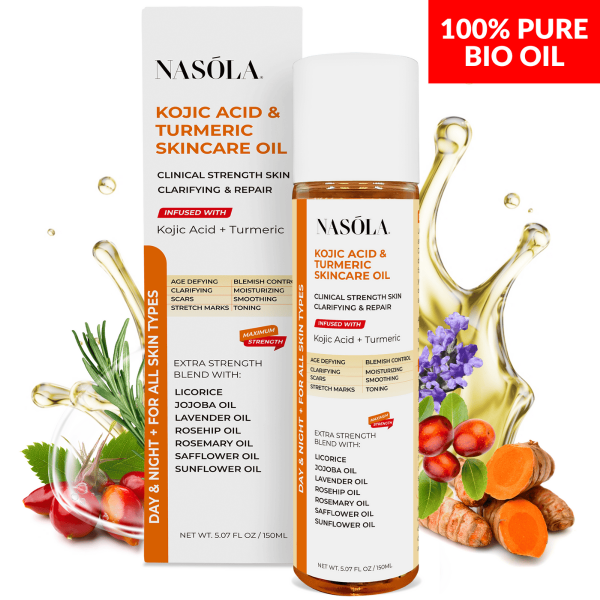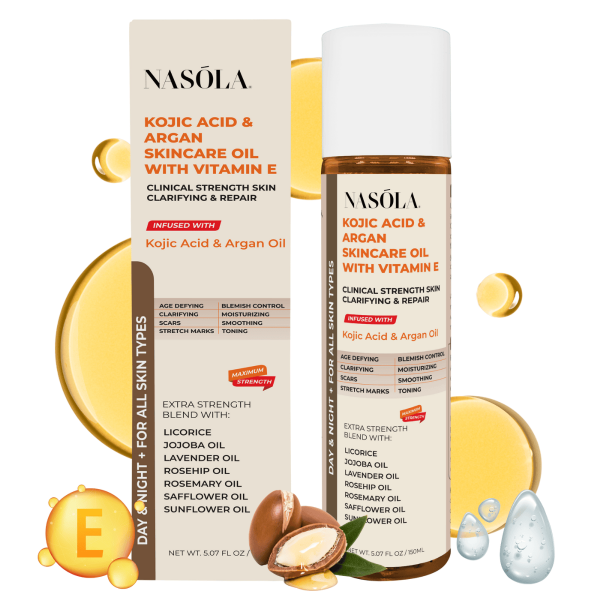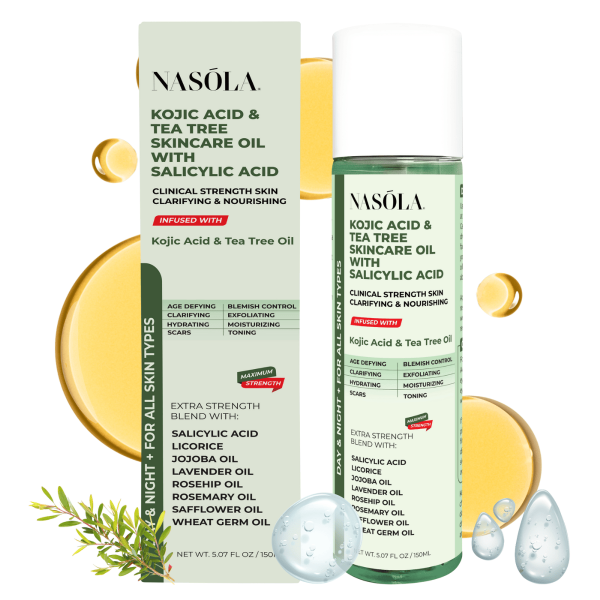Dry, flaky skin is hard to ignore. It tightens. Itches. Sometimes, even stings. And when your moisturizer seems to vanish into thin air? That’s when you need to reach for something more nourishing—like the best face oil for dry skin.
Face oils are game-changers for anyone dealing with persistent dryness. They seal in moisture, soothe irritation, and restore a silky-smooth texture. But the trick is—choosing the right one. Not all oils are created equal, and that’s where Nasola’s Kojic Acid Bio-Oils come in.
Each one, whether infused with turmeric, tea tree, or argan, is designed to tackle dryness while delivering added skin benefits like brightening, soothing, and barrier repair. Stick around, because I’m breaking down exactly what to look for in a face oil, when to use it, and why these specific blends deserve a front-row space on your vanity.
- Best Oil for Dry Skin on Face: What to Look For
- Best Face Oil for Dry Sensitive Skin
- Best Face Oil for Dry Skin Dermatologist Recommended
- Best Face Oil for Dry Skin: Unlock Hydration Throughout All Seasons
- Best Face Oil for Dry Skin by Concern: Pigmentation, Acne, Flakiness
- Ingredient Spotlight: Argan Oil’s Role in the Best Face Oil for Dry Skin
- Conclusion
- Frequently Asked Questions (FAQ)
Best Oil for Dry Skin on Face: What to Look For

When your skin feels like sandpaper no matter what you do, it’s not just thirsty—it’s dehydrated and in need of something extra. The best oil for dry skin on face goes beyond temporary softness. It repairs, restores, and transforms dull, rough skin into something supple.
Before you panic-buy six different oils, take a moment to understand what dry skin actually needs. Dehydrated skin lacks water, yes, but dry skin also struggles with oil production. When creams stop working, oils step in because they offer a more occlusive, nourishing layer. Especially when formulated with thoughtful ingredients… like these:
Understanding What Dry Skin Needs
The signs are obvious but easy to dismiss—tightness around the mouth, flaking at the forehead, dull complexion. These symptoms show your skin’s lipid barrier is compromised. And that’s where oils come to the rescue.
Traditional lotions often evaporate before they do the real work. That’s why the best oil for dry skin on the face should be able to:
- Rebuild the lipid barrier
- Lock in moisture effectively
- Restore resilience to surface cells
- Provide lasting nourishment (not just a quick glow)
Oil molecules are typically larger than water-based products, which means they sit on the surface longer, keeping moisture where your skin needs it most.
When used correctly, face oils won’t clog pores. Look for non-comedogenic labels and natural ingredients rich in fatty acids, antioxidants, and vitamins.
Key Ingredients to Hydrate and Nourish
What gives a face oil its magic? Ingredients. Read your labels, trust me—it makes all the difference.
Some superstar hydrating oils and actives to look for include:
- Argan Oil: Rich in vitamin E, sterols, and omega-6 fatty acids. Excellent for restoring elasticity and long-lasting hydration.
- Kojic Acid: Blocks melanin production, reducing spots and helping even skin tone.
- Turmeric Oil: Naturally anti-inflammatory and brightening. Reduces redness and hyperpigmentation.
- Tea Tree Oil: Antibacterial and clarifying. Great when dryness is combined with breakouts.
Nasola Kojic Acid + Argan Skincare Bio-Oil is loaded with argan oil, making it an MVP for anyone dealing with cracked, crepey skin. You’ll love its fast-absorbing texture and deeply hydrating finish.
If your moisturizer’s failing… this oil isn’t.
Best Face Oil for Dry Sensitive Skin

Now here’s the riddle—when your skin is dry AND sensitive, the hunt gets even tougher. You want hydration, yes, but without the sting, redness, or flare-up. That’s exactly why the best face oil for dry sensitive skin should be gentle and intentional.
Not all oils work for sensitive types. The trick is to go for formulations that are rich and soothing—but low in potential irritants. That includes avoiding added fragrance, essential oils with high volatility, or harsh actives in high concentrations. Here’s how you can choose smartly.
Why Sensitive Skin Needs Extra Care
Dryness is often misdiagnosed—it’s not just flaky skin but also slow healing, reactive texture, or post-use tightness. Combine that with inherently sensitive skin, and things get uncomfortable.
The safest oils for sensitive skin:
- Are fragrance-free and non-comedogenic
- Have anti-inflammatory, calming ingredients
- Use low concentrations of actives
- Improve elasticity without disrupting natural oils
This is where Nasola Kojic Acid + Turmeric Skincare Bio-Oil shines. It’s carefully crafted for those delicate skin days. The fusion of turmeric and kojic acid soothes dryness without irritation.
Top Gentle Oils to Consider
If your skin flushes at the drop of a hat or reacts to almost everything, lean into calming, replenishing oils.
Some of the best options for dry and sensitive skin include:
- Turmeric Oil: An ancient remedy. Naturally calming and incredibly capable of smoothing the skin’s surface.
- Kojic Acid: Reduces hyperpigmentation over time—without being too harsh.
- Argan Oil: Lightweight and packed with antioxidants that work even for the most reactive skin.
- Chamomile Infusions: For extra-calming power (though not found in all blends)
What I love most about Nasola’s turmeric blend is how it layers seamlessly with moisturizer or under SPF during the day. It’s light enough to soothe—but strong enough to work.
Not greasy. Not irritating. Just balanced, glowing skin.
Best Face Oil for Dry Skin Dermatologist Recommended

If your skin feels like it’s constantly thirsty—and nothing works—it’s time to bring in the combinational power of hydration and clarity. The best face oil for dry skin dermatologist recommended is typically non-comedogenic, clinically safe, and multifunctional. Your skin doesn’t just need moisture—it needs balance.
It’s no surprise that dermatologists approve of oils that protect the barrier, improve tone, and reduce blemish-causing congestion. Rather than rely on heavy creams or steroid-based treatments, try a specialized face oil with proven ingredients.
What Makes a Face Oil Dermatologist-Approved?
There’s more to “doctor-approved” than just “nice marketing.” These products generally check the following boxes:
- Hypoallergenic and safe for daily use
- Clinically tested or formulated with medically respected ingredients
- Include multifunctional actives like salicylic acid or kojic acid
- Target not only dryness, but fine lines, acne, or pigmentation
Because dry skin isn’t a one-size-fits-all condition—especially when it’s paired with other concerns like adult acne.
That’s where Nasola Kojic Acid + Tea Tree Skincare Bio-Oil with Salicylic Acid becomes a total standout.
The Importance of Targeted Ingredients
Dry but acne-prone? Oily only in the T-zone? Constant uneven texture? Dermatologists often advise integrating products that can multitask.
Enter salicylic acid—it exfoliates gently, keeping pore blockages low while tea tree tackles bacteria. Paired with kojic acid, this oil:
- Helps clear minor blemishes
- Fades dark acne spots
- Reduces surface flaking
- Injects real hydration back into parched skin
This formula is feather-light but laser-focused. If your breakouts confuse you—and your dry patches don’t quit—this oil gives balance a new name.
Best Face Oil for Dry Skin: Unlock Hydration Throughout All Seasons

Seasons change. And with them, so does your skin. What works in July may feel useless come January. That’s why choosing the best face oil for dry skin means being seasonally smart. You can’t hydrate the same in summer as you do in winter.
So what’s the secret? Flexibility. Opt for oils that adapt with your skin’s changing needs.
How Weather Affects Your Skin’s Hydration Levels
Think of your skin like a sponge. In humid air, it plumps. In the cold, it shrivels—unless you guard it.
How climate influences hydration:
- Cold, windy air strips the surface of natural oils
- Hot, dry environments trigger more water loss than you expect
- Indoor heat weakens the lipid barrier
- Summer sun adds another layer of sensitivity or damage
All of this means you can’t rely on the same routine year-round.
Switching Your Face Oil With the Seasons
What you need in winter isn’t what you need in spring. Good news: Nasola’s oils shift with your skin.
- Argan-based oil fits winter like a glove—rich, replenishing, and occlusive
- Turmeric-based oils reduce inflammation caused by sun exposure
- Tea tree and salicylic blends are perfect as you sweat more in hotter seasons
Keep them in rotation. Listen to your skin. And let your skincare evolve with your environment.
Best Face Oil for Dry Skin by Concern: Pigmentation, Acne, Flakiness

Dry skin is never just dry. Sometimes it’s dry and flaky. Or dry with dark spots. Or dry with stress-breakouts that won’t heal. So when choosing the best face oil for dry skin, think beyond hydration. Think targeted results.
Nasola’s Kojic Acid Bio-Oils are goal oriented. Whether your goal is brighter skin or calmer skin, each variety brings something unique to the table.
Brightening & Pigmentation Concerns
Got lingering dark spots from old pimples? Or patches of melasma? Dry skin can exaggerate these spots, making them look worse.
Face oils that help:
- Kojic Acid: Fades dark spots effectively by inhibiting melanin
- Turmeric: Offers natural brightening, especially helpful for stubborn hyperpigmentation
- Argan Oil: Makes skin look bouncier and more even
Nasola Kojic Acid + Turmeric Bio-Oil hits the sweet spot between skin-calming and spot-fading. Trust me—it’s worth the repetition.
When Dry Skin is Also Blemish-Prone
It’s frustrating. You combat dryness, only to wake up with clogged pores.
Here’s why: many people over-moisturize with comedogenic ingredients. You need clarifying oils, not thicker layers.
Best combo?
- Tea Tree Oil: Breaks down blemish-causing bacteria. Fast.
- Salicylic Acid: Clears dead skin inside the pore lining.
- Kojic Acid: Lightens the post-acne marks.
If that sounds like your skin type, grab Nasola Kojic Acid + Tea Tree Bio-Oil with Salicylic Acid. It fights on both fronts—surface hydration and pore clarity.
Ingredient Spotlight: Argan Oil’s Role in the Best Face Oil for Dry Skin

Ah, argan oil. Liquid gold, literally. And hands down one of the most underappreciated ingredients in the best face oil for dry skin you could find.
It’s rich, but never heavy. Light but ultra-nourishing. Here’s why it works wonders—especially in drier months or dehydrated skin phases.
Why Argan Oil Works for Dry Skin
You want a hydration hero? Argan oil’s got it all:
- Omega fatty acids restore the outer layer of skin
- Vitamin E boosts cell repair and smooths texture
- Fast-absorbing profile ensures no greasy feeling
- Lightweight texture makes it versatile all year
If your face feels tight hours after applying moisturizer, add a few drops of argan oil. Sometimes, that’s the missing piece in your skincare puzzle.
Best Product Featuring Argan Oil
Nasola Kojic Acid + Argan Bio-Oil nails it in terms of hydration and support.
Whether you’re battling winter-induced flaking or year-round tightness, this blend softens everything. It hydrates and tones at the same time, with that kojic acid glow as a happy bonus.
Your skin deserves to feel soft and nourished. This oil delivers just that.
Conclusion
Dry skin doesn’t have to be a life sentence.
With the best face oil for dry skin, you’re not just softening skin—you’re strengthening it from within. Oils like Nasola’s Kojic Acid Bio-Oil range give you targeted treatment based on need, mood, or season. Whether you need brightness, balance, or deep healing, there’s a match for you.
Using ingredients like argan oil, turmeric, kojic acid, and salicylic acid, these oils do more than hydrate—they transform. Add one to your morning and night routine, and you’ll see the difference not just in smoothness, but glow too.
✨ Go on, let your skin drink.
Frequently Asked Questions (FAQ)
The Nasola Kojic Acid + Turmeric Bio-Oil is excellent for dry, sensitive skin. It combines soothing turmeric and kojic acid to calm inflammation, moisturize dry patches, and fade dark spots. Plus, it’s lightweight and absorbs quickly without triggering sensitivity—making it ideal for delicate skin.
Generally no, especially if you opt for non-comedogenic formulas like Nasola Bio-Oils. These are thoughtfully crafted with ingredients like argan and tea tree oil, designed to hydrate without clogging pores. It’s essential to apply face oil sparingly and layer it after your moisturizer for the best protection.
Face oils provide an occlusive layer that helps lock in hydration, while moisturizers typically hydrate with water-based ingredients. Oils like those in the Nasola Kojic Acid Bio-Oil collection nourish, protect, and support the skin barrier—especially when used as the final step in your skincare routine.
Hands down, the Nasola Kojic Acid + Argan Skincare Bio-Oil is ideal for cold weather. Argan oil delivers deep hydration, helping your skin combat wind burn, indoor heating dryness, and seasonal flakiness like a champ.
Try the Nasola Kojic Acid + Tea Tree Bio-Oil with Salicylic Acid. It’s crafted to address both dryness and breakouts. Tea tree clears bacteria, while salicylic acid gently exfoliates and kojic acid fades acne marks. It’s a triple win for confused skin.
Twice daily is optimal—once in the morning and once before bed. Apply after your moisturizer to seal everything in. Nasola Bio-Oils absorb well without leaving a greasy residue, making them easy to layer into both AM and PM routines.
Absolutely! You can rotate or even mix a few based on your daily skin needs. For instance, use turmeric oil during the day to calm redness and argan oil at night for deep repair. Nasola oils are versatile and blend-friendly.
Not when paired with hydrating carriers like argan or turmeric oil. Nasola Kojic Acid Bio-Oils are formulated to minimize irritation while offering brightening benefits. Always patch test first, especially if you have known sensitivities.
Yes, though it’s best to apply oils during the opposite routine (AM vs. PM) or layer after retinoid application to reduce dryness. Nasola Bio-Oils can help mitigate retinol side effects like peeling or dryness.
Pigmented and dry? Opt for the Nasola Kojic Acid + Turmeric Bio-Oil. Turmeric brightens and calms, while kojic acid gently reduces dark spots—perfect for hydration and clarity.




